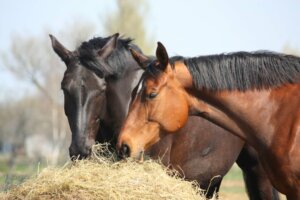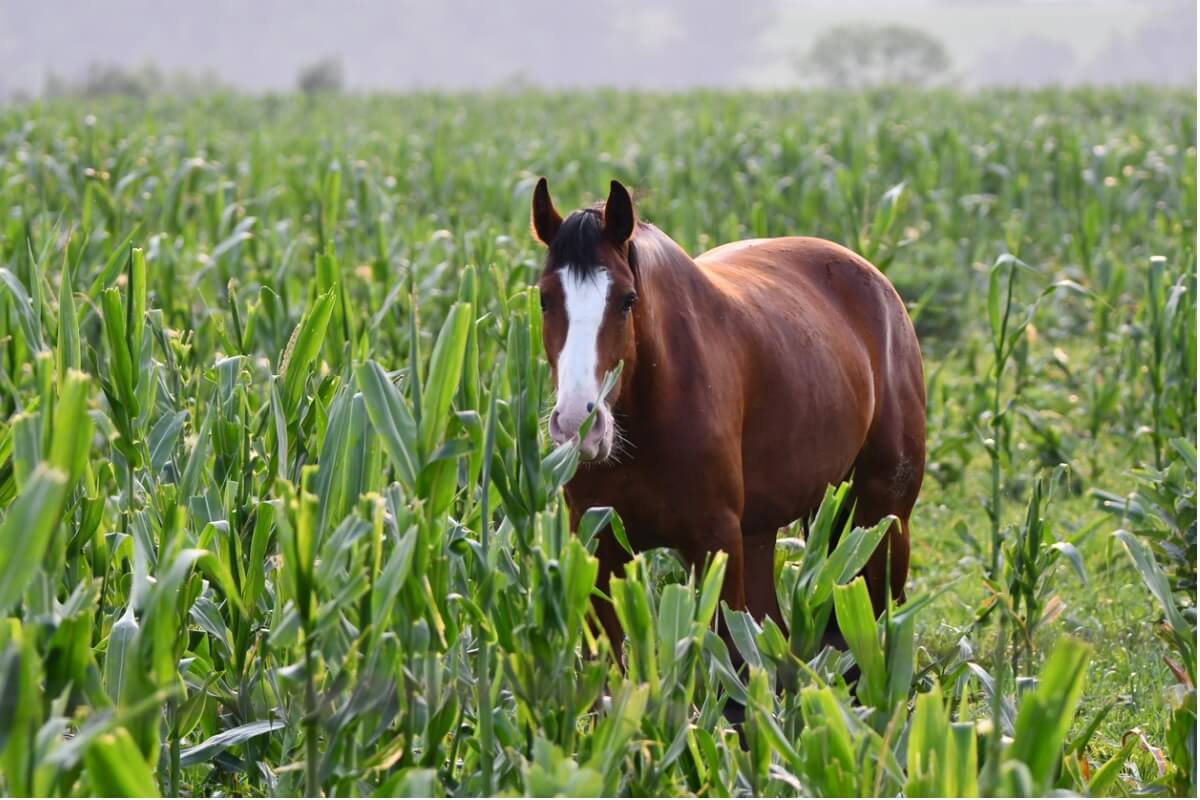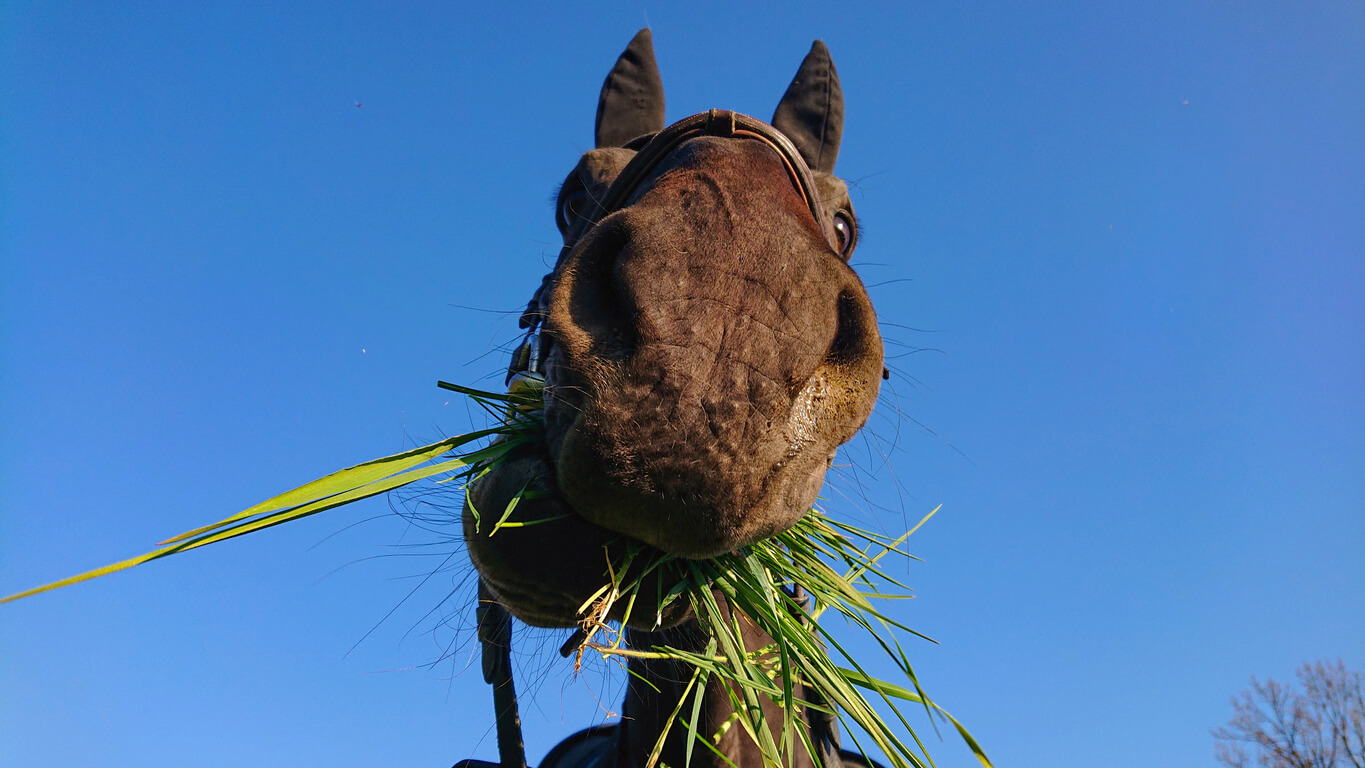What Do Horses Eat?


Written and verified by the biologist Cesar Paul Gonzalez Gonzalez
The horse is a domesticated species that can be found almost anywhere in the world. In their natural surroundings, these animals are well adapted to run on flat areas where vegetation abounds. In places like these, horses eat different food that helps them maintain their stocky and muscular bodies.
The species has the scientific name Equus caballus, which currently groups together several different breeds. These animals are popular and are used for recreational and sporting activities, so they must have a diet that supports this physical demand. Read on to find out what horses eat.
The life of a wild horse
Horses are associated with grassland, steppe, and shrubby plains environments. In fact, people believe that early populations of this animal occupied the regions of Hungary, Poland, and Mongolia, where there are several areas with ecosystems suitable for them. In these habitats, the specimens took advantage of the abundant grasses to feed.
The species has a herbivorous diet, so it can consume a wide variety of small plants, fruits, leaves, shoots, and bark. However, it doesn’t make good use of the nutrients in these foods. For this reason, horses eat throughout the day to meet their natural energy needs and the low amount of calories in their main dietary elements.

What’s the digestive system of the horse like?
Herbivores have a big problem when consuming plants, as the plant cells that constitute them are very difficult to digest. Therefore, horses have adaptations in their bodies that allow them to obtain energy from food with very few nutrients. The most important characteristics of their digestive system are listed below:
- Slow and careful chewing: Grinding is one of the most efficient processes when consuming plants, as it facilitates digestion and nutrient absorption. This can also be observed in other herbivores such as cows, bulls, and goats.
- Small stomach: This makes the digestive process faster. Horses don’t have a stomach like ruminants, so they don’t absorb nutrients from their diet well. However, they make up for this by increasing the number of times they eat per day.
- Small intestine with enzymes: In this area, there are enzymes that break down the food. This process isn’t very effective, but it helps them to use the food a little better.
- Large intestine with microorganisms: Some herbivores use the help of bacteria that live in the intestines to break down their food. In this way, plant nutrients are released and absorbed more easily.
What do domestic horses eat?
Domestic horses have the same type of diet as wild horses, so there aren’t many differences between the two. However, they are limited in the availability of their feed. These animals are fed fodder with high amounts of fiber in order to nourish them well. Some of the most common types of feed are as follows:
- Hay: This is dried fodder (stems, leaves, and seeds) obtained from legumes or cereals. Both options are rich in protein, fiber, and carbohydrates, making them an excellent food for horses.
- Pasture: Like wild horses, the domestic horse is able to feed on pasture. However, for this diet to contain sufficient nutrients, the horse must eat almost the whole day. For this reason, this diet is often supplemented with hay so as not to affect the animal.
- Toxic herbs (caution): It’s important to emphasize that some herbs that grow in pastures can be toxic to the horse, so you have to be very careful. Not every vegetable is suitable for feeding.
- Grains: This type of food is known to provide the horse with a lot of energy. Therefore, it’s only recommended in horses that have high energy needs, such as sports or load horses. Some examples within this group are oats, corn, barley, wheat, and rye.
- Fruits or vegetables: These are taken as treats for the specimens, as they can’t be part of their daily diet.
- Salt and minerals: Horses should consume minerals as a supplement in order to regulate the osmotic balance of their body. This is because horses lose these components through sweat and must be replenished through diet. However, pasture and hay lack these molecules. Because of this, they’re offered as salt blocks or as additives in the animal’s food.
Commercial feeds or concentrates
Certain commercial blends allow you to give the horse a standardized diet. This can be beneficial because it provides direct nutrients to the animal and is also very convenient for the owner.
However, a preset diet isn’t necessary for all types of horses. Feed is a good option to meet the body’s nutrition needs, but it isn’t essential. In fact, if they aren’t used carefully, they can lead to long-term health problems in the horse, such as obesity.

Horses benefit from the nutrients in plants (which are difficult to process). Although it may seem simple, these organisms have a complex digestive system that helps them cope with their surroundings. This characteristic has helped them to establish feral populations in countries like the United States, which reflects the adaptive capacity of these beautiful animals.
The horse is a domesticated species that can be found almost anywhere in the world. In their natural surroundings, these animals are well adapted to run on flat areas where vegetation abounds. In places like these, horses eat different food that helps them maintain their stocky and muscular bodies.
The species has the scientific name Equus caballus, which currently groups together several different breeds. These animals are popular and are used for recreational and sporting activities, so they must have a diet that supports this physical demand. Read on to find out what horses eat.
The life of a wild horse
Horses are associated with grassland, steppe, and shrubby plains environments. In fact, people believe that early populations of this animal occupied the regions of Hungary, Poland, and Mongolia, where there are several areas with ecosystems suitable for them. In these habitats, the specimens took advantage of the abundant grasses to feed.
The species has a herbivorous diet, so it can consume a wide variety of small plants, fruits, leaves, shoots, and bark. However, it doesn’t make good use of the nutrients in these foods. For this reason, horses eat throughout the day to meet their natural energy needs and the low amount of calories in their main dietary elements.

What’s the digestive system of the horse like?
Herbivores have a big problem when consuming plants, as the plant cells that constitute them are very difficult to digest. Therefore, horses have adaptations in their bodies that allow them to obtain energy from food with very few nutrients. The most important characteristics of their digestive system are listed below:
- Slow and careful chewing: Grinding is one of the most efficient processes when consuming plants, as it facilitates digestion and nutrient absorption. This can also be observed in other herbivores such as cows, bulls, and goats.
- Small stomach: This makes the digestive process faster. Horses don’t have a stomach like ruminants, so they don’t absorb nutrients from their diet well. However, they make up for this by increasing the number of times they eat per day.
- Small intestine with enzymes: In this area, there are enzymes that break down the food. This process isn’t very effective, but it helps them to use the food a little better.
- Large intestine with microorganisms: Some herbivores use the help of bacteria that live in the intestines to break down their food. In this way, plant nutrients are released and absorbed more easily.
What do domestic horses eat?
Domestic horses have the same type of diet as wild horses, so there aren’t many differences between the two. However, they are limited in the availability of their feed. These animals are fed fodder with high amounts of fiber in order to nourish them well. Some of the most common types of feed are as follows:
- Hay: This is dried fodder (stems, leaves, and seeds) obtained from legumes or cereals. Both options are rich in protein, fiber, and carbohydrates, making them an excellent food for horses.
- Pasture: Like wild horses, the domestic horse is able to feed on pasture. However, for this diet to contain sufficient nutrients, the horse must eat almost the whole day. For this reason, this diet is often supplemented with hay so as not to affect the animal.
- Toxic herbs (caution): It’s important to emphasize that some herbs that grow in pastures can be toxic to the horse, so you have to be very careful. Not every vegetable is suitable for feeding.
- Grains: This type of food is known to provide the horse with a lot of energy. Therefore, it’s only recommended in horses that have high energy needs, such as sports or load horses. Some examples within this group are oats, corn, barley, wheat, and rye.
- Fruits or vegetables: These are taken as treats for the specimens, as they can’t be part of their daily diet.
- Salt and minerals: Horses should consume minerals as a supplement in order to regulate the osmotic balance of their body. This is because horses lose these components through sweat and must be replenished through diet. However, pasture and hay lack these molecules. Because of this, they’re offered as salt blocks or as additives in the animal’s food.
Commercial feeds or concentrates
Certain commercial blends allow you to give the horse a standardized diet. This can be beneficial because it provides direct nutrients to the animal and is also very convenient for the owner.
However, a preset diet isn’t necessary for all types of horses. Feed is a good option to meet the body’s nutrition needs, but it isn’t essential. In fact, if they aren’t used carefully, they can lead to long-term health problems in the horse, such as obesity.

Horses benefit from the nutrients in plants (which are difficult to process). Although it may seem simple, these organisms have a complex digestive system that helps them cope with their surroundings. This characteristic has helped them to establish feral populations in countries like the United States, which reflects the adaptive capacity of these beautiful animals.
All cited sources were thoroughly reviewed by our team to ensure their quality, reliability, currency, and validity. The bibliography of this article was considered reliable and of academic or scientific accuracy.
- Chamorro Morán, J. T. La alimentación del caballo. Agricultura de las Américas (Colombia)(no. 163) P. 22-23, 32-35.
- Martínez, L. M. C. (2012). Alimentación del caballo: Importancia del heno. ExtremaduraPRE: la revista de la Asociación Extremeña de Criadores de Caballos de Pura Raza Española, (11), 32-33.
- Martínez Marín, A. L. (2009). NRC e INRA para raciones de caballos de ocio basadas en forrajes secos y concentrados granulados. Archivos de zootecnia, 58(223), 333-344.
- Marín, A. L. M. (2007) NUTRICIÓN DE CABALLOS DE OCIO ALIMENTADOS A PESEBRE. Producción animal y gestión. 5, 1-29
- Álvarez-Romero, J. y R. A. Medellín. 2005. Equus caballus. Vertebrados superiores exóticos en México: diversidad, distribución y efectos potenciales. Instituto de Ecología, Universidad Nacional Autónoma de México. Bases de datos SNIB-CONABIO. Proyecto U020. México. D.F
This text is provided for informational purposes only and does not replace consultation with a professional. If in doubt, consult your specialist.








